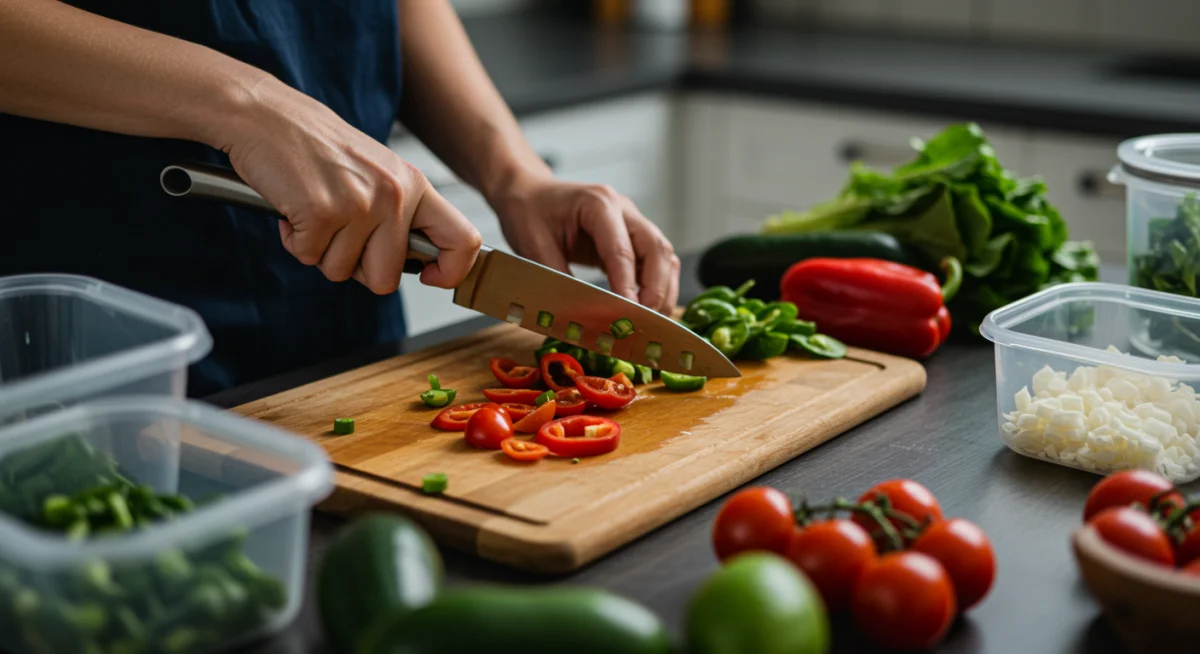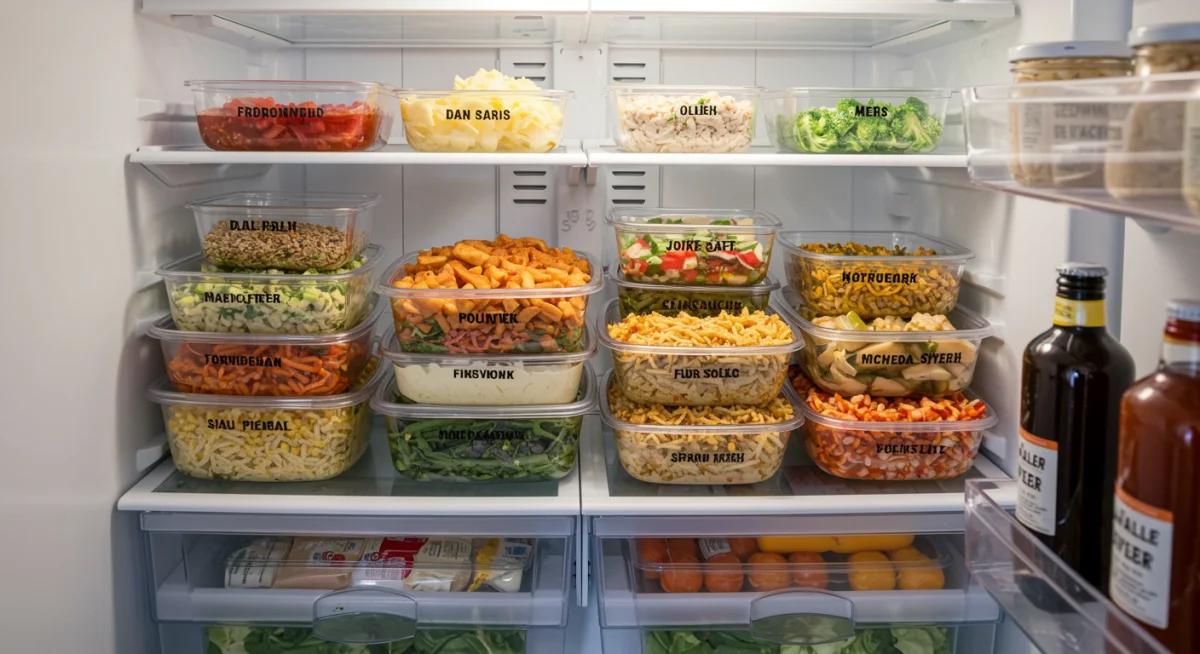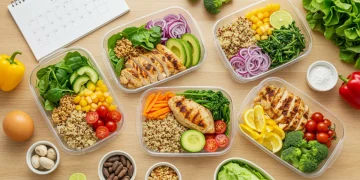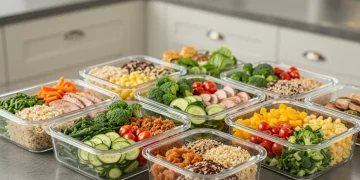Meal Prepping for Success: 5 Advanced Strategies to Save 10+ Hours Weekly on Healthy Eating

Implementing advanced meal prepping strategies can significantly cut down on weekly cooking time, allowing individuals to consistently adhere to healthy eating habits and reclaim valuable hours.
In today’s fast-paced world, finding time for healthy eating often feels like an impossible task. However, the solution isn’t about magic; it’s about mastering advanced meal prepping. This isn’t just about cooking in bulk; it’s a strategic approach to food preparation that can save you upwards of 10 hours every single week, transforming your diet and freeing up precious time.
Understanding advanced meal prepping: beyond the basics
Advanced meal prepping moves beyond simply cooking a large batch of chicken and rice. It involves a sophisticated understanding of nutrition, culinary techniques, and time management to create diverse, delicious, and healthy meals with minimal effort throughout the week. This approach focuses on maximizing efficiency and minimizing waste, ensuring that every hour spent in the kitchen yields maximum benefit.
To truly excel in advanced meal prepping, one must adopt a mindset of strategic planning. This means not just thinking about individual meals, but considering how ingredients can be repurposed, how cooking methods can be streamlined, and how nutritional needs can be consistently met. It’s about building a robust system that supports your health goals without demanding constant attention.
The foundational pillars of efficient meal prep
- Strategic menu planning: Design menus that share common ingredients or cooking methods to reduce prep time.
- Batch cooking principles: Cook staple ingredients in larger quantities, then diversify their use across multiple meals.
- Smart storage solutions: Utilize appropriate containers and labeling to maintain freshness and organization.
- Nutritional balance: Ensure each meal is balanced with proteins, carbohydrates, and healthy fats for sustained energy.
Ultimately, advanced meal prepping is about empowering yourself to take control of your diet and your time. It’s a skill that develops with practice, leading to a more organized kitchen, a healthier body, and a less stressed mind. By embracing these principles, you can transform your relationship with food and make healthy eating an effortless part of your daily routine.
Strategy 1: master ingredient batch preparation and rotation
The first cornerstone of advanced meal prepping is mastering ingredient batch preparation and rotation. This strategy focuses on cooking core components in large quantities and then skillfully incorporating them into a variety of different meals throughout the week. It’s about more than just efficiency; it’s about preventing palate fatigue and ensuring nutritional diversity.
Instead of preparing entire dishes, consider cooking individual components such as grains, proteins, and vegetables separately. For instance, roast a large tray of mixed vegetables, grill a significant amount of chicken breast, and cook a big pot of quinoa. These foundational elements can then be combined in countless ways, offering flexibility and preventing boredom.
Optimizing your batch cooking process
Effective batch cooking requires thoughtful planning regarding cooking methods and ingredient compatibility. Consider using appliances like slow cookers, instant pots, and sheet pans to cook multiple items simultaneously or with minimal oversight. This frees up your time to focus on other prep tasks or simply to relax.
- Multi-cooker magic: Utilize pressure cookers for grains and legumes, and slow cookers for tender proteins.
- Sheet pan versatility: Roast a variety of vegetables and proteins together for quick, flavorful components.
- Strategic seasoning: Keep initial seasoning light or neutral to allow for diverse flavor profiles later.
Once your components are cooked, the art of rotation comes into play. Transform roasted chicken into salads, wraps, stir-fries, or pasta dishes. Quinoa can become a base for grain bowls, a side dish, or even an addition to soups. This dynamic approach keeps meals interesting and ensures you’re getting a wide range of nutrients without starting from scratch each day.
By effectively batch preparing and rotating your ingredients, you significantly reduce daily cooking demands. This method not only saves considerable time but also encourages a more creative and flexible approach to healthy eating, making it sustainable in the long run.
Strategy 2: utilize advanced cooking techniques for speed and flavor
Beyond basic cooking methods, leveraging advanced cooking techniques can dramatically cut down on preparation time while simultaneously elevating the flavor profile of your meal-prepped dishes. This involves employing methods that are efficient, preserve nutrients, and allow for hands-off cooking, freeing you to multitask or simply relax.
Think beyond boiling and pan-frying. Techniques like sous vide, pressure cooking, and advanced roasting methods can transform tough cuts of meat into tender delights or cook grains perfectly in a fraction of the time. These techniques are often set-it-and-forget-it, making them ideal for busy individuals engaging in advanced meal prepping.
Embracing high-efficiency kitchen tools
Modern kitchen appliances are designed to make cooking faster and easier. Investing in and understanding how to effectively use tools like an Instant Pot, air fryer, or immersion circulator for sous vide can be a game-changer for your meal prep routine. These tools not only save time but often result in superior texture and flavor.
- The Instant Pot: Perfect for cooking large batches of grains, legumes, and even entire meals quickly.
- Air Fryer: Ideal for crisping vegetables or reheating prepped proteins, offering a healthier alternative to deep frying.
- Sous Vide: Ensures perfectly cooked proteins every time, allowing for hands-off cooking and easy reheating.
Furthermore, incorporating techniques that maximize flavor during the initial cooking phase means less need for extensive seasoning or sauce preparation later. For example, dry brining meats or marinating vegetables overnight can infuse deep flavors, making your prepped meals more satisfying and enjoyable.

By integrating these advanced cooking techniques, you not only save time but also elevate the quality and taste of your meals. This makes healthy eating more appealing and sustainable, solidifying your commitment to a well-prepped and nutritious lifestyle.
Strategy 3: implement strategic freezing and thawing protocols
Strategic freezing and thawing protocols are crucial for extending the life of your meal-prepped items and maintaining their quality and taste. This advanced strategy allows you to cook even larger batches than you might consume in a single week, ensuring you always have healthy options readily available and further reducing your active cooking time.
Not all foods freeze equally well, so understanding which components are best suited for freezing and how to properly prepare them is key. For instance, cooked grains, lean proteins, many cooked vegetables, and even some sauces freeze beautifully. However, items with high water content, like lettuce or cucumbers, tend to become soggy upon thawing.
Best practices for freezing prepped meals
To maximize the benefits of freezing, proper technique is essential. This includes using airtight, freezer-safe containers or vacuum-seal bags to prevent freezer burn. Labeling each item with the date and contents is also critical for efficient inventory management and ensuring you consume items within their optimal freshness window.
- Portion control: Freeze meals in individual portions for easy thawing and serving.
- Cool completely: Ensure food is fully cooled before freezing to prevent ice crystal formation.
- Airtight packaging: Use high-quality freezer bags or containers to protect against freezer burn.
Thawing protocols are just as important. The safest way to thaw food is in the refrigerator overnight. For quicker thawing, use the microwave on a defrost setting or place sealed packages under cold running water. Avoid thawing at room temperature, as this can encourage bacterial growth.
By mastering strategic freezing and thawing, you unlock a new level of efficiency in your meal prepping. This allows for greater flexibility, reduces food waste, and ensures that even on the busiest days, a nutritious, home-cooked meal is just moments away. It’s an invaluable tool for sustained healthy eating.
Strategy 4: master your pantry and fridge for ultimate efficiency
An often-overlooked aspect of advanced meal prepping is the optimization of your pantry and refrigerator. A well-organized and stocked kitchen is the silent hero behind a seamless meal prep routine. It allows for quick ingredient retrieval, reduces duplicate purchases, and minimizes decision fatigue, ultimately saving significant time and money.
This strategy involves more than just tidiness; it’s about intelligent inventory management. Know what you have, where it is, and what its shelf life is. This proactive approach ensures you always have the necessary ingredients on hand for your planned meals and can quickly identify items that need to be used soon.
Implementing a ‘first-in, first-out’ system
Adopt a ‘first-in, first-out’ (FIFO) system for your groceries. When you buy new items, place them behind older ones of the same type. This ensures that older ingredients are used first, preventing spoilage and waste. Labeling items with purchase dates can greatly assist in this process, especially for pantry staples and frozen goods.
- Designated zones: Assign specific shelves or drawers for different food categories (e.g., produce, dairy, proteins).
- Clear containers: Use transparent containers for pantry items to easily see contents and quantities.
- Inventory list: Maintain a running list of items, especially for freezer contents, to avoid overstocking.
Furthermore, consider dedicating a ‘meal prep zone’ in your fridge or pantry. This area holds all the ingredients or prepped components for your upcoming meals, making assembly quick and effortless. This level of organization reduces mental load and makes the entire meal prepping process more enjoyable and less daunting.

By mastering your pantry and fridge organization, you create an environment that supports efficient advanced meal prepping. This strategic approach ensures that every step of your food journey, from shopping to cooking to serving, is as streamlined and productive as possible.
Strategy 5: embrace dynamic meal components and flavor builders
The final advanced strategy for meal prepping success is to embrace dynamic meal components and flavor builders. This goes beyond simply cooking individual ingredients; it involves preparing versatile bases and concentrated flavor elements that can be combined in numerous ways to create diverse and exciting meals without extensive daily cooking.
Instead of thinking of a meal as a fixed entity, consider it a collection of interchangeable parts. For example, a large batch of roasted sweet potatoes can serve as a side, a base for a grain bowl, or even pureed into a soup. Similarly, a versatile sauce or dressing can completely transform the flavor profile of a simple protein and vegetable combination.
Creating a ‘flavor library’ for your meals
Develop a ‘flavor library’ of versatile sauces, dressings, and spice blends. These can be prepared in advance and stored, ready to be added to your base components to create entirely different dishes. Think of pestos, vinaigrettes, marinades, or even a simple chili oil. These concentrated flavor boosters are key to preventing meal prep boredom.
- Versatile sauces: Prepare a large batch of a neutral sauce (e.g., tomato, peanut, or tahini-based) that can be customized.
- Spice blends: Mix your own spice rubs for proteins or vegetable seasonings to add instant flavor.
- Infused oils/vinegars: Create herb or garlic-infused oils to drizzle over finished dishes.
Another aspect of dynamic components is preparing ‘mini-meals’ or ‘snack packs’ that can be combined or eaten individually. These could include pre-portioned nuts and seeds, chopped fruits and vegetables, or hard-boiled eggs. These small, healthy additions can complement your main meals or serve as quick, nutritious snacks.
By embracing dynamic meal components and flavor builders, you infuse creativity and flexibility into your advanced meal prepping. This strategy ensures that your healthy eating journey remains engaging and delicious, making it easier to stick to your goals and save significant time each week.
| Key Strategy | Brief Description |
|---|---|
| Ingredient Batch Prep | Cook staple components in bulk, then rotate their use across diverse meals. |
| Advanced Cooking Techniques | Utilize tools like Instant Pot, air fryer, or sous vide for faster, hands-off cooking. |
| Strategic Freezing | Properly freeze and thaw meals to extend shelf life and ensure constant availability. |
| Dynamic Flavor Builders | Prepare versatile sauces, dressings, and spice blends to diversify meal flavors. |
Frequently asked questions about advanced meal prepping
The primary benefit is significant time savings, often 10+ hours weekly, coupled with consistent access to healthy, home-cooked meals. It simplifies adherence to dietary goals and reduces stress associated with daily cooking decisions.
Advanced meal prepping involves strategic planning, ingredient rotation, and the use of efficient cooking techniques to create diverse meals from batch-prepared components, rather than just cooking large quantities of the same dish.
Key tools include an Instant Pot for quick cooking, an air fryer for crisping, sous vide immersion circulators for precise protein cooking, and high-quality airtight containers for storage and freezing.
Prevent boredom by mastering ingredient rotation, creating versatile flavor builders like sauces and spice blends, and planning menus that allow for diverse combinations of prepped components throughout the week.
When done correctly, frozen meal prep can retain significant nutritional value. Freezing locks in nutrients, especially if foods are frozen soon after cooking. Proper thawing and reheating are crucial to maintain quality.
Conclusion
Embracing advanced meal prepping is more than just a culinary hack; it’s a lifestyle transformation. By meticulously planning, utilizing efficient cooking methods, intelligently managing ingredients, and creatively building flavors, you can significantly reduce the time spent in the kitchen while consistently enjoying delicious, healthy meals. These five advanced strategies provide a robust framework to reclaim over 10 hours weekly, fostering a sustainable approach to well-being and allowing you to invest that saved time into other meaningful aspects of your life. Start implementing these techniques today and experience the profound positive impact on your health, finances, and free time.





